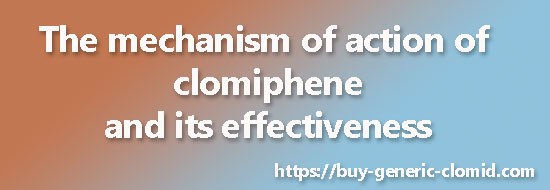Action of clomiphene: According to the hypothesis, clomiphene directly stimulates the hypothalamus-pituitary-ovary system, which in turn affects the gynothalamic-pituitary system. This hypothesis is confirmed by clinical data that have shown the possibility of increasing the release of estrogens after taking clomiphene without first increasing FSH.
This hypothesis is also confirmed in experimental studies. Thus, Smith and Doy showed that when clomiphene is added to a medium containing testosterone and placental microsomes, the production of estrogens from testosterone increases by 1.6 times. The Hammerstein data indicate the possibility of enhancing the synthesis of progesterone from acetate in the human yellow body (in vitro) with the addition of large amounts of clomiphene by activating the 3-b-ol-dehydrogenase enzyme system. At the same time, with an increase in the dose of clomiphene, the synthesis of progesterone is sharply inhibited.
According to Israel, both assumptions should be accepted as important working hypotheses; obviously, clomiphene has the possibility of a dual effect, which is confirmed by an increase in the excretion of both gonadotropins and estrogens in women with removed ovaries. This can be explained by enzyme changes in the biosynthesis of estrogens not only in the ovary, but also in the adrenal gland, which causes an increase in the synthesis of estradiol, which in turn causes the release of gonadotropins necessary for ovulation.
Currently, it is known that clomiphene increases the release of FSH and LH as a result of binding to estrogen-dependent receptors of the hypothalamus, which causes the development of a follicle in the ovary and the appearance of an estradiol peak preceding the ovulatory peak of gonadotropins. At the same time, estrogens increase the sensitivity of the pituitary gland to Gn-RH and the ovaries to gonadotropins, which leads to ovulation. A partially local effect of clomiphene on the ovary is also possible.
Action of clomiphene
Thus, clomiphene performs its biological effect mainly due to its anti-estrogenic effect, which activates the gonadotropic function of the pituitary gland. Clomiphene has found wide application for the treatment of patients with endocrine forms of infertility due to its ability to stimulate ovulation.
Clomiphene can be used in patients with mild ovarian hypofunction, an incomplete luteal phase, with dysfunctional uterine bleeding, oligomenorrhea, as well as in women with sclerocystic ovaries. Clomiphene is also used in patients with amenorrhea as a functional test before treatment with hopadotropins and in combination therapy in combination with gonadotropins. The drug is usually prescribed for 50-100 mg, starting from the 5th day of the menstrual cycle or from the 5th day from the beginning of a menstrual-like reaction caused by progesterone.

The course of treatment usually lasts 5-7 days. In the absence of an effect, the dose of clomiphene is increased to 100-200 mg per day and repeated courses of treatment are prescribed, sometimes up to 5-6. To illustrate the dependence of the effectiveness of treatment on the dose of the drug, we present data from Roland.
Most often, ovulation occurs during the first course of treatment with small doses (50 mg for 5 days). Inslcr and Lunenfeld believe that it is still necessary to prove the existence of a relationship between the dose of the drug and the level of increase in gonadotropins, as well as the frequency of ovulation. Among patients who have ovulation, the percentage of pregnancy varies between 15-30.
According to the summary data of the Merrell laboratory, which synthesized action of clomiphene for clinical use for the first time, 1,454 out of 5,569 patients (24%) had 1,654 pregnancies; 1,223 of them were full-term, and 100 women had twins or triplets. In 22% of cases, the pregnancy ended with a spontaneous abortion. This percentage is quite high if we compare these data with the number of spontaneous abortions in “healthy” women (10%). At the same time, in women who have suffered from primary infertility for a long time, the percentage of spontaneous abortions is 20, and in secondary infertility — 24.8
Thus, the frequency of spontaneous abortions in patients treated with clomiphene is approximately the same as in women suffering from infertility, when treated with other methods. According to the summary data of this laboratory, 28 out of 1938 fetuses (1.44%) had such malformations as cleavage of the upper lip and palate, polydactyly, Down’s disease, microcephaly.